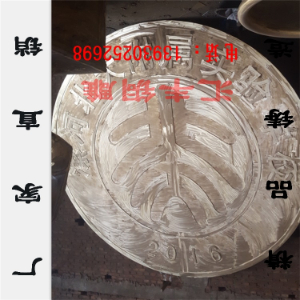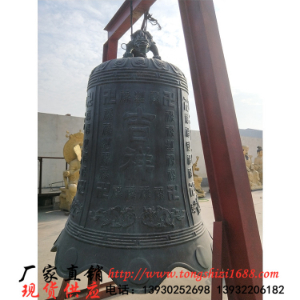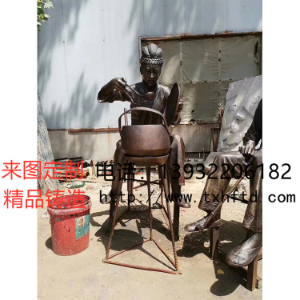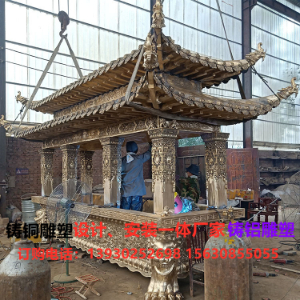铜弥勒佛有哪些象征意义
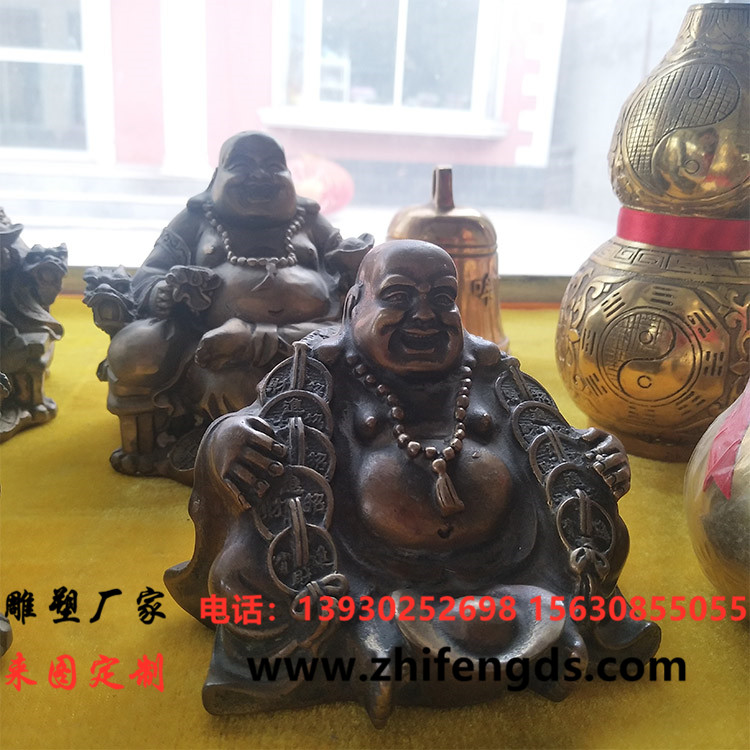
铜弥勒佛坐像通高92厘米。青铜质。弥勒圆脸肥腮,大耳垂肩,眉角低垂,笑眼眯缝,大嘴张开作大笑状;脖颈粗短,饰两道肉褶;坦胸露乳,腹部凸起左手执布袋,右手垂于屈立的右膝上;半结跏趺坐姿,左腿盘曲,右腿支立,足坐于台上,双足肥大。整体造型突出了弥勒佛笑口常开、大肚能容、慈可爱平易近人的特征。弥勒佛原称弥勒菩萨,是佛教八大菩萨之一,因为他是释迦牟尼佛的继任者,所以被尊称为弥勒佛。弥勒佛共有三个形象。形象出现在十六国时期,是交脚弥勒菩萨形象。第二个形象出现在北魏时期,演变为禅定式或倚坐式佛装形象。第三个形象五代开始出现,即我们现在常见的象其特征为肥头大耳、咧嘴长笑、身荷布袋、袒胸露腹、盘腿而坐的胖和尚形象该形象取材于布袋和尚契此,因此弥勒佛的形象也是外来宗教中国本土化的一个典型代表(铜雕厂家)
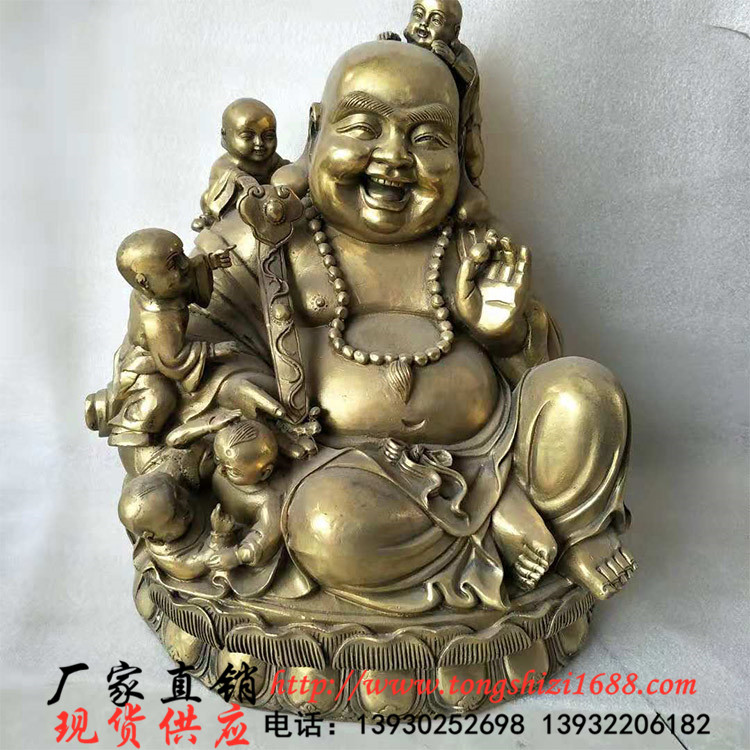
The statue of tongmaitreya Buddha is 92 cm high. Bronze. Maitreya has round face, fat cheeks, big earlobe shoulder, low eyebrow angle, narrow smile eyes, open mouth and laugh like a laugh; his neck is thick and short, decorated with two meat pleats; he has a flat chest, exposed breast, bulged abdomen, left hand holding a cloth bag, right hand hanging on the bent right knee; he sits in a half knot posture, left leg curling, right leg supporting, feet sitting on the stage, feet fat. The overall shape highlights the features of Maitreya Buddha, such as smiling, big belly, being kind and approachable. Maitreya Buddha was originally called Maitreya Bodhisattva, one of the eight Bodhisattvas of Buddhism. Because he is the successor of Sakyamuni Buddha, he is honored as Maitreya Buddha. Maitreya Buddha has three images. The image appeared in the Sixteen Kingdoms period, which is the image of Jiaojiao Maitreya Bodhisattva. The second image appeared in the Northern Wei Dynasty, and evolved into a Zen or reclining Buddha image. The third image began to appear in five generations, that is, the image of fat monk, which is now common to us, is characterized by fat head and big ears, grinning, carrying a cloth bag, exposing his chest and abdomen, sitting cross legged. This image is based on the cloth bag monk Qi. Therefore, the image of Maitreya Buddha is also a typical representative of the localization of foreign religion in China.
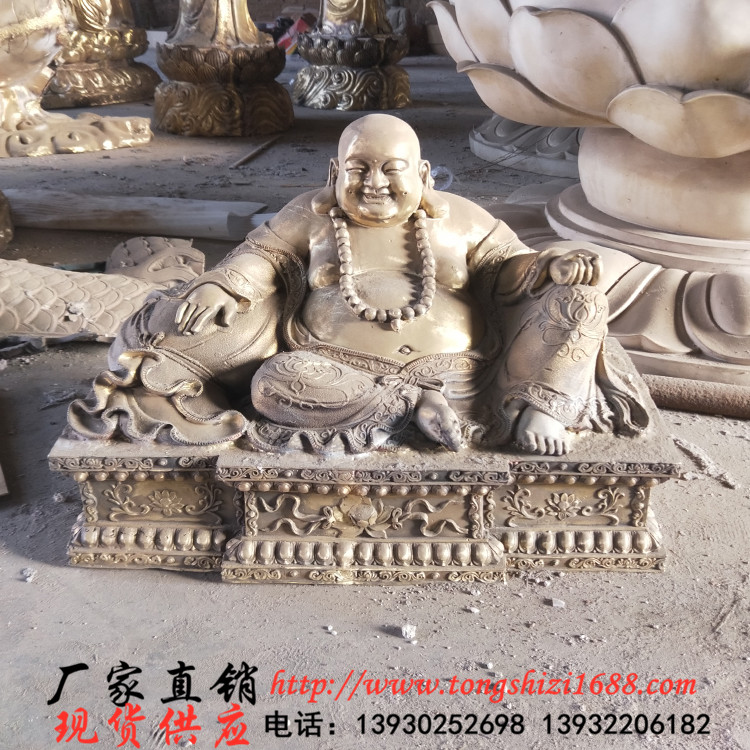
铜弥勒佛坐像通高92厘米。青铜质。弥勒圆脸肥腮,大耳垂肩,眉角低垂,笑眼眯缝,大嘴张开作大笑状;脖颈粗短,饰两道肉褶;坦胸露乳,腹部凸起左手执布袋,右手垂于屈立的右膝上;半结跏趺坐姿,左腿盘曲,右腿支立,跣足坐于台上,双足肥大。整体造型突出了弥勒佛笑口常开、大肚能容、慈祥可爱、平易近人的特征。弥勒佛原称弥勒菩萨,是佛教八大菩萨之一,因为他是释迦牟尼佛的继任者,所以被尊称为弥勒佛。弥勒佛共有三个形象。个形象出现在十六国时期,是交脚弥勒菩萨形象。第二个形象出现在北魏时期,演变为禅定式或倚坐式佛装形象。第三个形象五代开始出现,即我们现在常见的象特征为肥头大耳、咧嘴长笑、身荷布袋、袒胸露腹、盘腿而坐的胖和尚形象。该形象取材于布袋和尚契此,因此弥勒佛的形象也是外来宗教中国本土化的一个典型代表。
The statue of tongmaitreya Buddha is 92 cm high. Bronze. Maitreya has a round face, fat cheeks, big earlobe shoulder, low eyebrow angle, narrow smile eyes, open mouth and laugh like a laugh; his neck is thick and short, decorated with two meat pleats; he has a flat chest and exposed breast, his abdomen is raised, left hand is holding the bag, right hand is hanging on the right knee that is bent; he sits in a half knot, left leg is curled, right leg is supported, barefoot is sitting on the stage, and his feet are fat. The overall shape highlights the features of Maitreya Buddha, such as smiling, big belly, amiable, amiable and approachable. Maitreya Buddha was originally called Maitreya Bodhisattva, one of the eight Bodhisattvas of Buddhism. Because he is the successor of Sakyamuni Buddha, he is honored as Maitreya Buddha. Maitreya Buddha has three images. Personal image appeared in the Sixteen Kingdoms period, is the image of Maitreya. The second image appeared in the Northern Wei Dynasty, and evolved into a Zen or reclining Buddha image. The third image of five generations began to appear, that is, the image of fat monk that we now commonly see is characterized by fat head and ears, grinning, body and cloth bag, open chest and belly, cross legged and sitting. The image of Maitreya is based on the cloth bag monk, so the image of Maitreya Buddha is also a typical representative of the localization of foreign religions in China.

弥勒佛像在中国有很高的知名度,形成弥勒信仰,它的影响也是很大的。在汉代,弥勒佛像的佛经,被大量翻译成汉语。弥勒佛像在民间普遍受到信奉。弥勒佛像是中国广为流传的一尊佛,此佛常怀慈悲之心。中国常把弥勒佛像拿来供奉,因此有了弥勒佛像雕刻。中国自古以来就是一个传统文化古国,中国部分信仰佛教。人们把佛像看的十分重要。摆放佛像也有一定的说法。拿弥勒佛佛像来说。弥勒佛像的供养和一般的神像供养不同 ,因为弥勒佛像是未来佛 除去每天三炷香的香火供养外,每月十五,应该用“御守盐”调和清水为神像洗守盐为东密佛教特有的祈福、结印、开光、用的盐本身具有很强的性,可沟通天地神灵,所以定期用御守盐清洗神像、神龛是很需要的。每月农十八日、或者特别大事来临前需要祈愿求福时,应该在“御守宣”写上愿望,之后放在香炉上焚化。要供奉弥勒佛像一定要了解它,避免一些忌讳。
Maitreya statues are well-known in China, forming Maitreya belief, and its influence is also great. In the Han Dynasty, the Sutra of Maitreya Buddha was translated into Chinese. Maitreya Buddha is widely believed in among the people. Maitreya Buddha is one of the most popular Buddhas in China. This Buddha is always compassionate. In China, Maitreya statues are often used for worship. Therefore, Maitreya statues have been carved. China has been an ancient country of traditional culture since ancient times. Part of China believes in Buddhism. It is very important for people to see the Buddha. There is also a certain way to put Buddha statues. Take the statue of Maitreya Buddha. Maitreya Buddha's offering is different from that of other deities, because Maitreya Buddha's offering is in the future. In addition to three incense incense offerings a day, on the 15th day of each month, we should use "Yushou salt" and water to wash and conserve salt for the deities, which is unique to Eastern Buddhism. The salt used for praying, printing, lighting and using has a strong nature and can communicate with the gods and spirits of the world. Therefore, we should regularly use Yushou salt to clean the deities, Shrines are needed. When it is necessary to pray for blessings on the 18th day of each month, or before special events come, it is necessary to write down the wishes in the "Imperial Guard propaganda" and then burn them on the censer. To worship Maitreya, we must understand it and avoid some taboos.
推荐资讯 / Recommended News
- 【2020-08-30】艺术性的无价之宝“铜雕工艺”
- 【2020-08-28】公园铜雕塑有什么意义?
- 【2020-08-26】雕塑成为城市精神集中的体现
- 【2020-08-25】铜雕塑的制作过程
- 【2020-08-23】城市雕塑的作用
- 【2020-08-21】河北唐县铜雕塑文化特殊之处
- 【2020-08-18】精品定制铸铜大型铜香炉
- 【2020-08-13】校园铜雕塑的文化涵养
